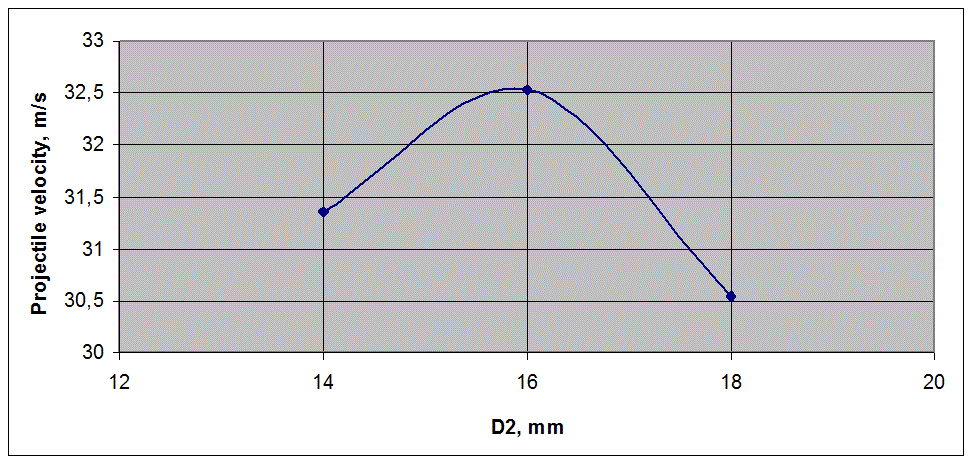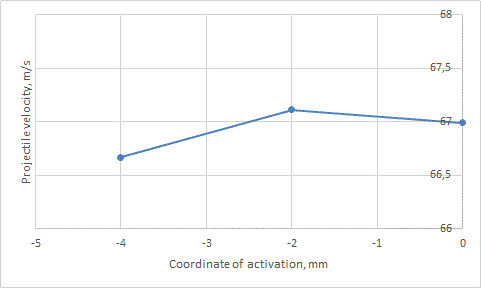Calucations for original "bistage" EM-4 coilgun will be placed here.
As the bistage configuration means connected function of two coils, I was forced to write a script describing two-windidng system. Besides "traditional" parameters it is capable to set:
- separation of the coils;
- start arrow position in coil (position of nose of the projectile in relation to front end of the first coil);
- coordinate of deacitvation of the first coil (position of the projectile when the coil is switched off);
- time delay between the deactivation of the first (transistor-controlled) coil and activation of the second (SCR-controlled) coil.
Besides, as the arrow-shaped projectile is planned to be utilized, I used part of the code written for EM-3 coilgun.
The resulting script is here: http://coilgun.ucoz.ru/FEMM_calc/EM-4/bistage.lua.
The calculation was conducted for 3 initial speeds of the projectile: 3 m/s (meaning some velocity after "feeding" coil), 30 m/s (second stage), 60 m/s (last stage). The capacitances were suggested to decrease with stage number (totally 5 stages were planned): 450 mkF for the first stage (ESR 33 mOhms), 300 mkF for 2-3 stages (ESR 50 mOhms) and 150 mkF for 4-5 stages (ESR 33 mOhms). Initial voltage was 400 V, projectile caliber 5.5 mm, its mass 3 g, inside coil diameter (i.e. the outside diameter of the barrel) 7 mm. The case when approx. equal quantitis of the energy are dissipated on both coils of the bistages is suggested (i.e. the discharge on the first coil is down to ~285 V) - this is most appropriate according to preliminary evaluations.
Some pictures visualizing the resuls obtained are below.
Lets begin from the first (bi)stage.

Fig. 1. Dependence of the projectile speed from the outside diameter of the second (SCR-controlled) coil D2.
As one can see, the optimal coil's diameter is 16 mm. In a similar way it can be demonstrated the the optimal D1 = 20 mm, and best wire diameter makes 0.3 mm for the first coil and 0.5 mm for the latter one.
What is about the second bistage?
Fig.2 shows the influence of the delay of activation of the second coil

Fig. 2. Dependence of speed from the delay of activation. Designations: CA = coordinate of activation, CD = coordinate of deactivation of the first (transistor-controlled) coil.
It is clear that the influence is negligible. Other parameters (such as the diameter of the coils) dominate.
Fig. 3 shows how the speed depends on the diameter of the second coil. Its optimal value is 16 mm (which coincides with one for the first coil).

Fig. 3. Speed vs 2nd coil diameter for the second bistage.
Fig. 4 sets the optimal activation coordinate to be about - 2 mm (i.e. the projectile is 2mm before the front end of the first coil), which is the same for intial speeds of 3 and 60 m/s.

Fig. 4. Speed vs CA for the second bistage (initial velocity 30 m/s).
At last, following results obtained for 60 m/s initial speed:
 |
 |
Fig. 5. Results for the conventional last stage (60 m/s starting speed).
Conclusions:
1) All bistages can be wound with the same wire - 0.3 mm for the first coil and 0.5 mm for the second. The optimal length of all coils appeared to be 16 mm.
2) The optimal activation coordinate of all bistages is calculated to be - 2 mm. Delay before activation of the second coil(s) has very low influence and in fact may be set to zero.
The latter facts allow serious simplifications of the construction of our gauss gun - all bistages can be driven from the fixed photosensors directly, without any additional timing.
3) The calculated peak current in all coils doesn't make more than 100 A.
This allows using only one transitor switch to drive all construction (IRGPS60B120KDP IGBT is planned).
4) Calculated efficiency is rather high and makes more than 10 % for the last stage.
I assumed 6% effifency initially, which gives about 66 m/s with 108 J stored in caps (nine 150 mkF 400 V caps, the tenth is suggested to be utilized in "feeding" coil which pulls the projectile into the barrel) and 3 g projectile. But now I may hope to get more than 70 m/s...
Lets wait for the experimental results.